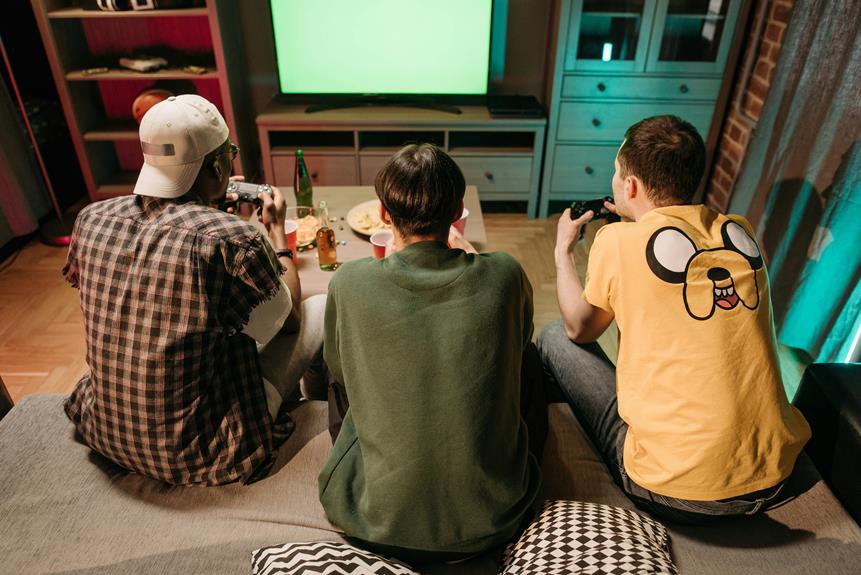
When buying a TV for gaming, it's vital to consider various factors that can significantly impact your gaming experience. From screen size and resolution to input lag and refresh rate, each aspect plays a crucial role in ensuring smooth gameplay and immersive visuals. However, there's one often overlooked factor that can make a substantial difference in your gaming sessions. Can you guess what it is?
Screen Size and Resolution
When choosing a gaming TV, consider the optimal screen size and resolution for an immersive gaming experience. The screen size plays a crucial role in your gaming setup. A larger screen provides a more immersive experience, making you feel like you're truly in the game world. It can enhance your gameplay by allowing you to see more details and have a wider field of view. However, be mindful of the size of your gaming room to ensure that the screen isn't too big for comfortable viewing.
Resolution is equally important when it comes to gaming. A higher resolution, such as 4K, delivers sharper images with more detail, allowing you to see textures and graphics more clearly. This can significantly enhance your gaming experience, making everything look more realistic and vibrant. Keep in mind that a higher resolution may require more powerful hardware to run games smoothly at the best visual settings.
Input Lag and Response Time
Considering your gaming experience, understanding the input lag and response time of a gaming TV is vital to ensuring optimal gameplay performance. Input lag refers to the delay between pressing a button on your controller and the action happening on the screen. A lower input lag is crucial for fast-paced games where split-second reactions can make a difference between winning and losing. Look for TVs with input lag below 30 milliseconds for a smooth gaming experience.
Response time, on the other hand, is the time it takes for a pixel to change from one color to another. A lower response time reduces motion blur and ghosting, resulting in clearer images during fast movements in games. Aim for a response time of 5 milliseconds or less for minimal visual artifacts.
When shopping for a gaming TV, prioritize models with low input lag and quick response times to enhance your gaming sessions. These factors can significantly impact your gameplay, making your gaming experience more immersive and enjoyable.
Refresh Rate and Motion Handling
To optimize your gaming experience, pay close attention to the refresh rate and motion handling capabilities of a gaming TV. The refresh rate refers to how many times per second the screen refreshes the image, typically measured in Hertz (Hz). A higher refresh rate, such as 120Hz or 144Hz, can provide smoother motion and reduce motion blur, crucial for fast-paced gaming where quick reactions are key. Additionally, consider the TV's motion handling features like motion interpolation or black frame insertion, which can further enhance motion clarity.
When choosing a gaming TV, aim for a higher refresh rate to ensure a more fluid gaming experience. Keep in mind that some TVs offer variable refresh rates like FreeSync or G-Sync, which synchronize the TV's refresh rate with the frame rate output of your gaming console or PC for optimal performance. These technologies can prevent screen tearing and stuttering, resulting in a seamless gameplay experience. By prioritizing refresh rate and motion handling capabilities, you can immerse yourself fully in your gaming world with minimal distractions.
Gaming-specific Features
For an enhanced gaming experience, focus on the gaming-specific features of the TV you're considering. Look for a TV with low input lag, as this is crucial for gaming. Input lag refers to the delay between pressing a button on your controller and seeing the corresponding action on the screen. A lower input lag ensures a more responsive gaming experience, giving you a competitive edge in fast-paced games.
Another important gaming-specific feature to consider is variable refresh rate technology, such as AMD FreeSync or NVIDIA G-Sync. These technologies help to reduce screen tearing and stuttering, providing smoother gameplay by synchronizing the TV's refresh rate with the frame rate output of your gaming console or PC.
Additionally, check if the TV supports HDR (High Dynamic Range) content. HDR enhances the contrast and color accuracy of games, resulting in more vibrant and realistic visuals. This feature can significantly improve your gaming immersion and overall enjoyment.
Lastly, consider TVs with game mode settings that optimize picture quality for gaming. Game mode can reduce input lag further and enhance visual clarity, giving you the best possible gaming experience on your new TV.




